Md. taking tentative steps toward clean construction rules: ‘How we buy things matters’
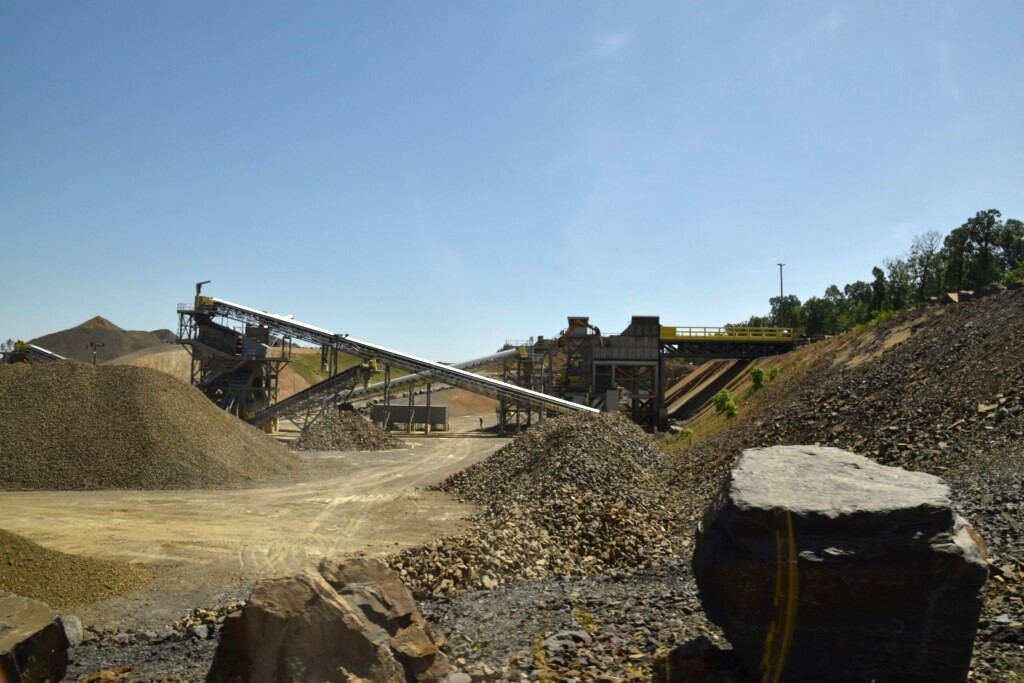
Diesel-belching trucks are rumbling down Maryland 550 in Woodsboro at high rates of speed.
It’s a pretty remote stretch of highway in Frederick County, surrounded mainly by cornfields. Many of the trucks are stopping at Laurel Sand and Gravel, a massive quarry and mining operation off the main road, where 600,000 tons of small stones are ground into powder every year. The powder, known as aggregate, is sold to the concrete industry as a thickening agent.
The property is pockmarked by mounds of rocks and gravel, giant construction equipment, and industrial-sized chutes, tunnels, bridges and conveyor belts. It’s also got a natural deep pool, which is used as a training ground for U.S. and Israeli military divers, local first responders and police deepwater investigators. The Frederick County government had to grant the property a special zoning designation to allow for commercial scuba diving operations.
Amidst this clamorous contemporary moonscape, a local businessman, Brad Hill, is thinking about a carbon-free future — but taking his inspiration from Ancient Rome. Hill, who leases most of the land to Laurel Sand and Gravel, also runs a business there called Comus Sustainable Pozzolan Products.
Hill has invented a way to dramatically reduce the pollutants that go into the concrete manufacturing process. His patent relies on mixing cement without burning coal and other toxins at high temperatures. And he’s using a natural thickener, Pozzolan, that’s as old as civilized society itself.
“You have clean cement because you don’t have to use fossil fuels in our product,” Hill — a trained astrophysicist — explains.
Not only is it climate-friendly, he asserts, but it’s cheaper and considerably more durable than most of the concrete on the market.
Hill’s once-lonely quest to produce cleaner cement and concrete is now finding receptive ears in government and in certain sectors of the building industry itself. The fledgling “Buy Clean” movement for the construction and building industries, which focuses on using less carbon-intensive materials, is becoming embedded in federal policy, with a goal of zero carbon emissions in the construction sector by the year 2050.
“This helps fill an enormous hole in the push to reduce industrial emissions,” said Jason Walsh, executive director of the BlueGreen Alliance, a national coalition of labor unions and environmental organizations. Speaking last week at a Washington, D.C., conference on the Buy Clean idea, sponsored by the BlueGreen Alliance and Third Way, a centrist Democratic think tank, Walsh described Buy Clean not just as an effort to combat climate change, but as a way to reinvigorate the country’s struggling manufacturing sector and create good-paying union jobs.
Four states, led by California, have enacted Buy Clean laws of their own. And just a few weeks ago, a dozen states, including Maryland, signed on to the Federal-State Buy Clean Partnership, a proposed procurement policy. The state governments have committed to seeking lower-carbon infrastructure materials, including concrete and steel, in state-funded projects. And they’ve agreed to collaborate with the federal government and one another in an effort to transform the marketplace.
The federal-state partnership, Walsh said, “will give certainty to businesses that there is a large, stable market to buy these cleaner products. How we buy things matters.”
Maryland may also be taking tentative steps toward establishing a Buy Clean policy of its own for construction.
A bill that passed in the House of Delegates last month would instruct the Maryland Department of General Services to assess the global warming impact of each category of cement or concrete mixture used in the construction of a public project. Beginning July 1, 2025, state agencies would be required to specify in each solicitation for a government-funded construction project the cement or concrete mixture that would be used in the building materials, and prioritize proposals with the lowest carbon footprint. Bidders would be required to submit environmental product declarations — a fairly new concept in the building sector that has been described as nutrition labels for greenhouse gas emissions.
The bill, which stalled during last year’s General Assembly session, has a week to make it through the Senate and to Gov. Wes Moore’s (D) desk.
One large multinational cement company has embraced the legislation, and so have environmental groups, which argue that any attempt to regulate the emissions of the construction industry creates a benefit for the climate.
“How can you know the environmental impact of a building or structure if you don’t know what the products are going into it are going to be doing?” said Zachary Lovett, a Baltimore-based project pursuit manager for Holcim US, part of a Swiss building construction materials conglomerate.
But some construction industry associations in Maryland are opposing the measure, saying it would place too much of a financial burden on smaller companies that do not have the ability to keep a large inventory of concrete mixes or stick an environmental label on every one of their products. And they suggested that any state Buy Clean program should run through the Maryland Department of Transportation rather than the Department of General Services, because so many construction projects, like roads and the massive operations at the Port of Baltimore, are controlled by MDOT.
In written testimony, Marshall Klinefelter, president of the Maryland Asphalt Association, said his group’s members appreciate the intent of the legislation, but “strongly feel that the market should dictate the types of materials needed for construction projects. If these vague determinations are set, we have serious concerns that it will make it nearly impossible to adhere to. Setting preferences also pits producers against each other, giving an unfair advantage to those that meet the requirements.”
The bill would, however, provide state grants for ready-mix concrete companies to buy the technology they need to make cleaner concrete.
“I don’t see any way how, if this bill goes through, it puts any companies at a disadvantage,” Lovett said. “In fact, I think it gives the smarter companies an advantage.”
The measure passed 103-31 in the House on March 20. Every Democrat present voted for it, along with five Republicans. The bill and its Senate companion are now sitting in the Senate Budget and Taxation Committee, which has held hearings on both versions.
‘The most widely used material on the planet besides water’
The building industry is one of the worst polluters on the planet, because concrete is so ubiquitous. It’s not just used on roads and buildings but on bridges and dams, ports and airports, trails and sidewalks, playgrounds, swimming pools, skate parks, patios, fountains, statuary, indoor construction, and so much more.
“Concrete is the most widely used material on the planet besides water,” is how Del. Ken Kerr (D-Frederick), the House sponsor of the Buy Clean bill in Annapolis, puts it.
The concrete industry accounts for about 8% of global greenhouse gas emissions, and most of that is attributable to the way cement is made, in a kiln, often fueled by coal, that heats to over 2,500 degrees Fahrenheit. That creates a chemical reaction with a high level of carbon emissions. When cement is mixed with water, sand and other aggregates like those mined and crushed at Laurel Sand and Gravel in Frederick County, it becomes concrete.
“If the concrete industry were a country, it would be in the top five of carbon-producing nations in the world,” said state Sen. Sarah Elfreth (D-Anne Arundel), the Senate sponsor of the state’s green construction legislation.
The U.S. government is using its purchasing power to try to combat climate change. The federal government is the largest direct purchaser in the world and one of the leading funders of infrastructure projects. It owns 8,000 buildings across the country and is the largest purchaser of electric power. It’s also the largest fleet operator in the U.S.
The Biden administration is targeting decades-old methods of manufacturing and urging the building industry to find alternative, less carbon-intensive ways of producing cement and concrete, steel and other construction materials.
The Inflation Reduction Act, for example, includes $6 billion for the Department of Energy to dole out grants to concrete and cement manufacturers to find alternative means of production.
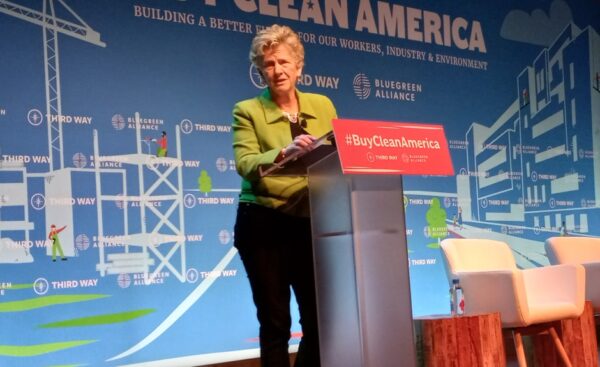
Robin Carnahan, administrator of the U.S. General Services Administration, at a Buy Clean conference in Washington, D.C., last week. Photo by Josh Kurtz.
The administration announced last year that it was creating a Federal Buy Clean Initiative, prioritizing the purchase of low carbon materials for government construction projects, with a goal of covering 98% of materials purchased by the federal government. The U.S. Department of Transportation, the Environmental Protection Agency and General Service Administration and other agencies are developing regulations to favor contractors that use low-carbon products on building projects.
Robin Carnahan, the administrator of the General Services Administration, told the Buy Clean conference in D.C. last week that her agency is targeting asphalt, concrete, glass and steel as it develops regulations for cleaner construction.
“Turns out that the four are pretty heavy emitters of carbon in the supply chain,” she said. “These supply chain emissions are things we know we’re going to be able to make a significant impact on.”
And there’s an international component to the government’s effort: Through John Kerry, the erstwhile U.S. senator and secretary of State who is serving as President Biden’s envoy on climate change, the U.S. has organized major corporations from across the globe into the First Movers Coalition. These companies have agreed to purchase at least 10% near-zero carbon cement and concrete for their operations by 2030.
Four states have passed Buy Clean laws of their own. And New Jersey is working on a regulation that not only sets benchmarks for concrete manufacturers to meet but provides financial incentives for companies that go beyond the proposed climate-friendly standards.
Buy Clean is also now on the radar of the U.S. Climate Alliance, the coalition of two dozen states and territories, including Maryland, that formed after former President Trump pulled the U.S. out of international climate pacts. While there are no formal agreements yet between the states, one goal, said Kareem Hammoud, a senior policy analyst at the U.S. Climate Alliance, is ensuring that whatever Buy Clean standards they enact are reasonably well-aligned with one another, so construction industry suppliers do not have to scramble from state to state.
“We’re not just target-setting organizations,” Hammoud said. “Governors commit to real action.”
“But for many states,” he conceded, “this is a very new area.”
‘This isn’t new stuff’
Brad Hill calls himself “a cement guy.” He has owned construction companies and helped build power plants, cement plants and other energy infrastructure. He was working as a civil contractor at the Lehigh Cement plant in Union Bridge — 10 miles from Woodsboro — when he bought the company’s quarry in Woodsboro 15 years ago. He wasn’t sure what he’d do with it. “I had to figure out what I’d bought,” he recalled.
Eventually Hill came to realize that the rock deposits on the property, formed from the wearing down of the Appalachian Mountains, contained many of the same properties that are found in the volcanic ash at Mount Vesuvius in Italy — which literally helped build the Roman Empire. Hill thought about the durability of so many of the buildings and infrastructure from Ancient Rome, including famous structures like the Pantheon and the Colosseum, and compared that to the dramatically shorter life-cycle of modern concrete.
“This isn’t new stuff,” he said. “This is 2,000-year-old stuff that we’ve got here.”
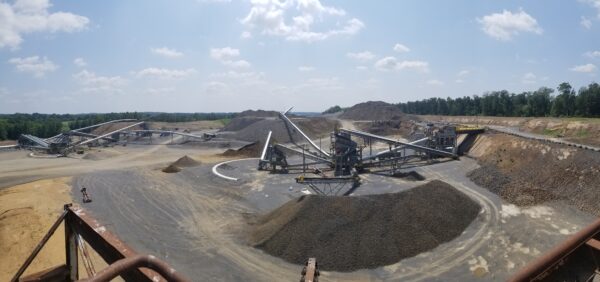
Another view of the quarry in Woodsboro. Photo courtesy of Brad Hill.
Hill concluded that he wanted to start promoting the use of Pozzolan in U.S. construction. He also thought about how the concrete industry essentially tries to reproduce the natural chemical explosions of a volcanic eruption, but in an unnatural, carbon-intensive way.
“We burn so much fossil fuel to get it to mimic Vesuvius,” he said.
So he began tinkering and eventually invented a system that he says reproduces the chemical reaction at cold temperatures, powered by giant rollers controlled by air currents, rather than using extreme heat. Thus, the so-called Hill Process was born, and Hill launched Comus Sustainable Pozzolan Products as a spinoff of one of his construction companies.
Hill believes that by using a less carbon-intensive method of producing concrete, he can help reduce greenhouse gas emissions in several ways: Through the cold-temperature chain reaction, which in turn will produce concrete that weighs half as much as standard concrete and has a greater life cycle, which in turn will require fewer road repairs, which contribute to climate change, and fewer truck trips to quarries like the one he owns and that’s used by Laurel Sand and Gravel.
Down the road at Hill’s old employer, executives at Lehigh Hanson, Inc., which operates the Lehigh Cement plant in Union Bridge, announced last summer that the plant would fully transition from producing ordinary Portland cement to making an eco-friendly product, beginning this year. The company said it was using new technology to reduce the energy required to produce the product and associated emissions — making for a carbon footprint that is up to 10% less than ordinary Portland cement.
But some people in the industry say it’s easy for big companies to make dramatic changes and substantial investments in new products and equipment. Lehigh Cement is owned by Heidelberg Materials, a German-based international company.
“If you’re forcing smaller firms to manage and hold different types of concrete, essentially what you’re doing is pushing out some of the smaller guys,” said Michael Sakata, president and CEO of the Maryland Transportation Builders and Materials Association.
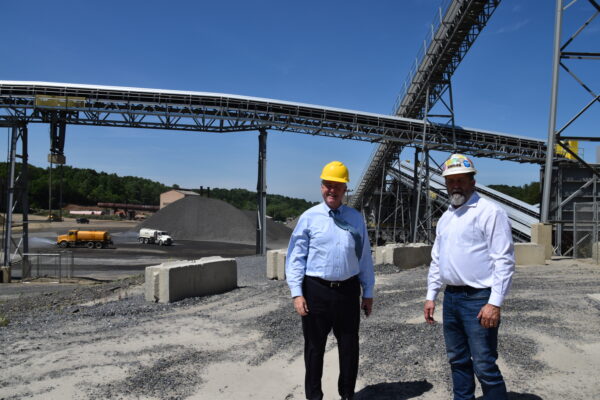
U.S. Rep. David Trone (left) and Brad Hill, owner of Comus Sustainable Pozzolan Products, at Hill’s quarry in Frederick County. Photo courtesy of the office of U.S. Rep. David Trone.
Sakata said that many manufacturers are making innovations to reduce greenhouse gas emissions when they can, “but if we are going to invest and make things cleaner, we definitely need a push” from the federal government.
Hill feels the same way. While U.S. and European regulators are evaluating his method for creating greener concrete, he and a team of scientists continue to refine the system.
“Breaking big rocks into little rocks is big science,” he says.
Last summer, U.S. Rep. David Trone (D-6th) visited his quarry, and Hill credits Trone and other members of Maryland’s congressional delegation for embracing his work and securing funding for operations like his. But for now, the money is caught in the federal bureaucracy.
So Hill tinkers, waits, and hopes — and envisions one day doing more to fight climate change.
“I’ve been working my entire life for this,” he says.



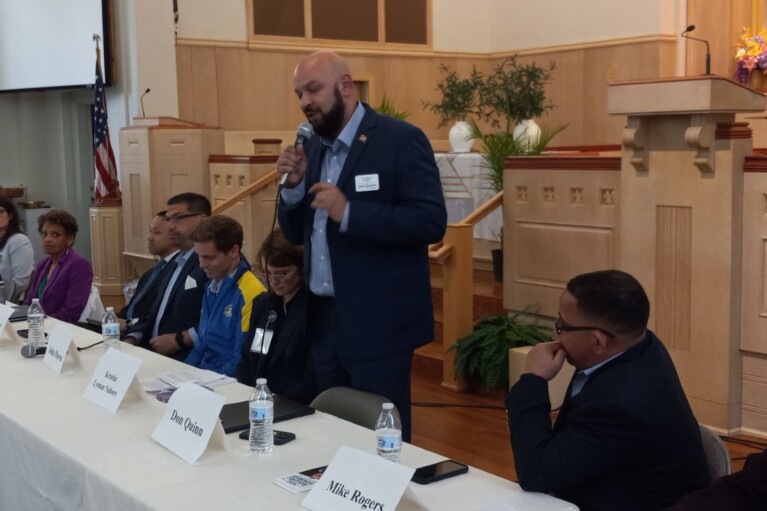
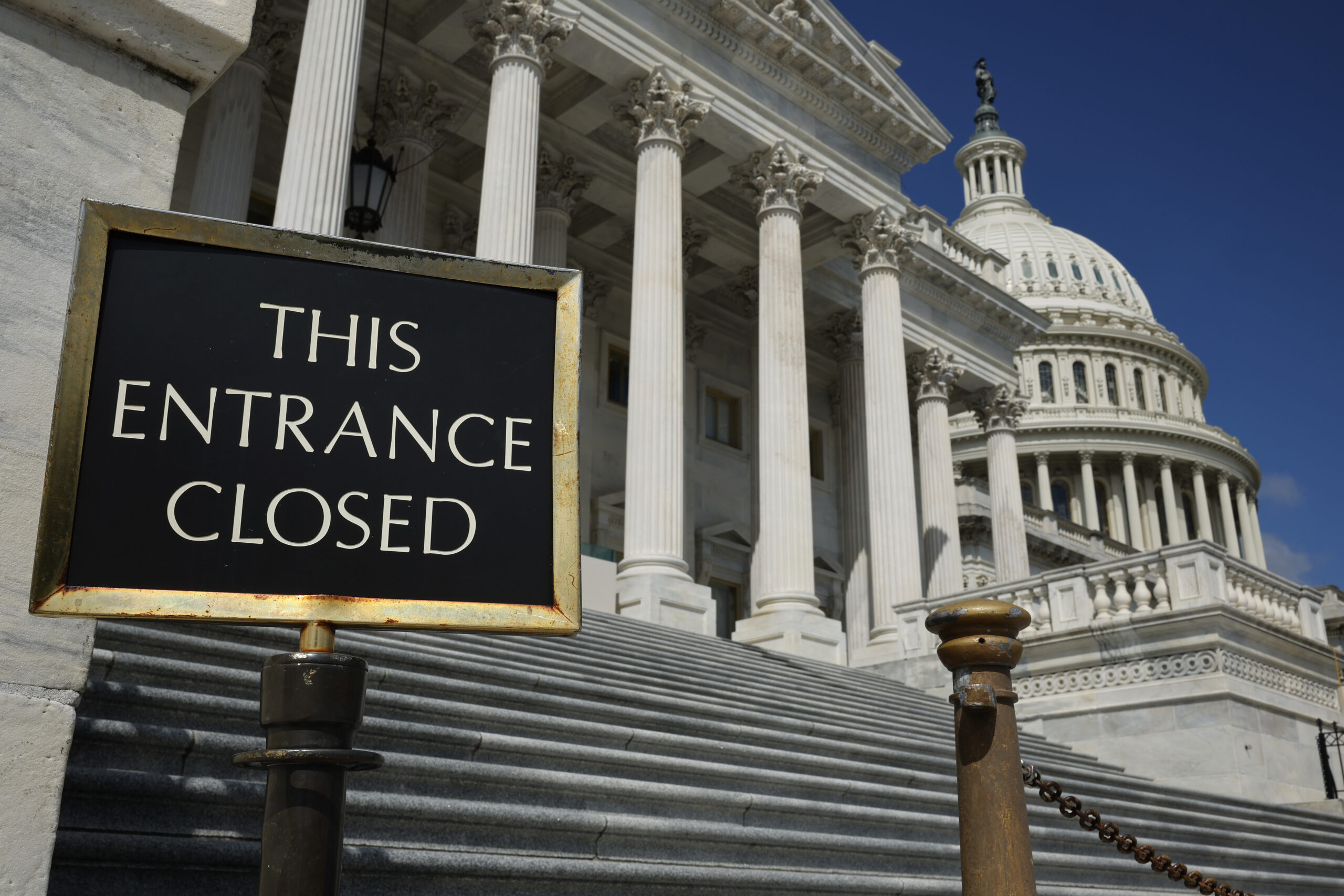
 Creative Commons Attribution
Creative Commons Attribution